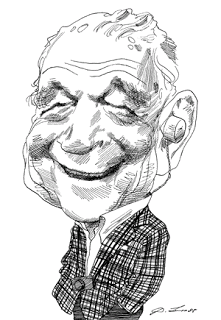I've had a good read this afternoon, and it has been informative to some degree, however ...Ed Yong has taught me that good science communication doesn't have to be dumbed down, it just has to be pitched right, and while I am no Ed Yong, I say, challenge accepted! Let me know how it goes!
I have an 8 year old son, and due to questions we both have, we have had some very interesting laypeople's conversations about the nature of experience and "the mind" (is it a thing, a physical thing, a process?) as well as such things as memory, embodiment and perception.
It seems it would be really helpful for us (and by extension, possibly many others?) if you could summarise the broad strokes of your theory in some way in which an intelligent 8 year old (and his father!) could understand.
Would this be possible?
What Does Cognitive Science Want to Know?The basic question in cognitive science (psychology plus related fields like linguistics, computer science, neuroscience, philosophy and more) boils down to this: "Why did that person do the thing they just did, in the way that they did it?" There are two basic answers to this question; the computational and the ecological approaches.The Computational ApproachIf you look at what goes into the person from the environment (sensations) and look at what comes out (behaviours), they don't look anything alike. Sensations (input) clearly have to be taken, altered, processed until a behavior (output) can be generated. The main thing sitting in between sensation and behavior is the brain, and it's clearly built in ways that enable it to do this kind of processing, transforming work. The mainstream view in cognitive science is therefore that people do what they do because the brain makes us. Cognitive science therefore needs a way to talk as precisely (read: mathematically) as possible about those brain-based processes.The ideas that makes this possible come from computer science. Pioneers like Claude Shannon and Alan Turing invented the maths that made it possible to take (almost) any input and process it into (almost) any output. All the maths that make it possible for your computer to take some input (e.g. a mouse click) and transform that into an action (e.g. taking you from one web page to another) were now available to carefully describe the processes of the brain.We therefore end up with this basic hypothesis: the form of our behavior is caused by computational mental and neural processes that transform input into that output, and we need all this because our perceptual contact with the world (through sensations) is not rich enough to explain the form of the behaviours we can get up to.
James J Gibson
The Ecological, Embodied ApproachIt turns out, however, that there was a psychologist (James J Gibson) who spent the better part of 40 years figuring out that our perceptual contact with the world is, in fact, amazingly rich and detailed. People realised that Gibson's theory might offer a way to think about perception that could replace the need for mental representations and computations; suddenly there was another option. The key to the ecological approach is that the brain is not the only place where the good stuff happens. Our environments offer some opportunities for action and not others (Gibson called these 'affordances'), our bodies enable us to do some things and not others, and the way our bodies perceive and act in their environments allows all this to change in interesting, complex but not random ways. As soon as it becomes possible that the form of our behavior can be caused by something other than just the brain, everything changes. The job of the brain changes from "process input into output" to "link body and environment through perception and action". The brain is no longer necessarily a computer, because computation is no longer necessarily the thing that has to happen to get to behavior. The difference between the two approaches to behavior is captured by the slogan, 'Ask not what is inside your head; ask what your head is inside of'. A Simple ExampleHow does a baseball outfielder catch a fly ball? In terms we've been using so far, we want to know the form of the actions the outfielder takes and how that relates to various ways of solving the problem.The computational strategy is to detect the initial motion off the ball from the bat and then to predict where it will land. You can technically do this because the physics of projectile motion (motion caused by an initial force and then left to run without any more help) is fairly straight forward and you can predict where the ball will go pretty quickly. This account predicts that the form of the outfielder's behavior will be to run in a straight line (the shortest distance) from where they are to where they need to be.There are two ecological strategies. Fly balls follow a curved path and they change speed (they slow to a stop at the top, then speed back up as they fall). The two strategies are to move so as to cancel out one aspect of this motion. Optical Acceleration Cancellation predicts that the outfielder's behavior will be to run with varying speed that tries to offset the acceleration of the ball. Linear Optical Trajectory predicts that the outfielder's behavior will be to run along a curved path that tries to cancel out the curvature of the ball's path. Weirdly, it turns out that if you succeed at either of these, you will arrive in the right place at the right time to catch the ball.The data unambiguously support the ecological strategies. Outfielders never simply run to the predicted landing location; instead they run along curved paths at varying speed in various combinations of the two perception based strategies. The form of their behavior maps directly onto the form of the perception of the environment. Whenever the details of the perceptual coupling to the environment have been worked out and tested, human behavior always shows the various tell-tale signatures of online perceptual control, rather than mental prediction. While there are many tasks still to solve, so far so good. I hope that helps; comments and questions welcome, I'm keen to fine tune this as much as possible!
A Simple ExampleHow does a baseball outfielder catch a fly ball? In terms we've been using so far, we want to know the form of the actions the outfielder takes and how that relates to various ways of solving the problem.The computational strategy is to detect the initial motion off the ball from the bat and then to predict where it will land. You can technically do this because the physics of projectile motion (motion caused by an initial force and then left to run without any more help) is fairly straight forward and you can predict where the ball will go pretty quickly. This account predicts that the form of the outfielder's behavior will be to run in a straight line (the shortest distance) from where they are to where they need to be.There are two ecological strategies. Fly balls follow a curved path and they change speed (they slow to a stop at the top, then speed back up as they fall). The two strategies are to move so as to cancel out one aspect of this motion. Optical Acceleration Cancellation predicts that the outfielder's behavior will be to run with varying speed that tries to offset the acceleration of the ball. Linear Optical Trajectory predicts that the outfielder's behavior will be to run along a curved path that tries to cancel out the curvature of the ball's path. Weirdly, it turns out that if you succeed at either of these, you will arrive in the right place at the right time to catch the ball.The data unambiguously support the ecological strategies. Outfielders never simply run to the predicted landing location; instead they run along curved paths at varying speed in various combinations of the two perception based strategies. The form of their behavior maps directly onto the form of the perception of the environment. Whenever the details of the perceptual coupling to the environment have been worked out and tested, human behavior always shows the various tell-tale signatures of online perceptual control, rather than mental prediction. While there are many tasks still to solve, so far so good. I hope that helps; comments and questions welcome, I'm keen to fine tune this as much as possible!


